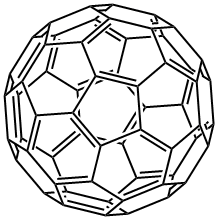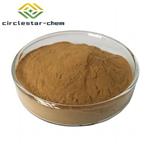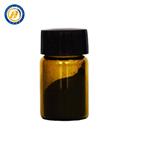Description
Fullerenes are molecules that composed entirely of carbon. They are similar in structure to graphite, which is composed of a sheet of linked hexagonal and pentagonal rings that prevent the sheet from being planar. Each carbon atom on the surface of fullerenes is bonded to three carbon neighbors, therefore, is sp2 hybridized. Fullerenes are in the form of a hollow sphere, ellipsoid, tube, and many other shapes. Spherical fullerenes C60, the first fullerene molecule manufactured in 1985, is named as buckminsterfullerene, resembles the balls used in football. Cylindrical fullerenes are known as carbon nanotubes (CNTs). As the discovery of fullerenes came after buckminsterfullerene, the shortened name “fullerene” is used to refer to the family of fullerenes, of which each carbon atom is covalently bonded to three others.
The most specific feature of fullerenes is that they are excellent electron acceptors (n-type semiconductors), which are suitable for organic electronic materials with electron carriers. Fullerenes can be used to fabricate polymer/fullerene blend for organic photovoltaics, in which fullerene acts as the n-type semiconductor. Fullerenes are powerful antioxidants, which react readily and at a high rate with free radicals. These free radicals usually lead to cell damage or death. Therefore, fullerenes show great promise in health and personal care applications, in which the prevention of oxidative cell damage or death is desirable. Fullerenes are also used in non-physiological applications, where oxidation and radical processes are destructive (food spoilage, plastics deterioration, metal corrosion). Research interests on fullerenes include also the use of fullerenes to control the neurological damage of diseases such as Alzheimer’s disease and Lou Gehrig’s disease. Fullerenes are used as additives for polymers to create copolymers or composites with specific physical and mechanical properties. Fullerenes can be doped with rubidium and cesium to fabricate superconductors with electron carriers, of which the superconducting transitions occur at more than 30 K.
Uses
High purity carbon 60 fullerenes for use in thermal evaporation systems as either electron acceptors, n-type semiconductors or interface layers.
References
[1] K. Tanigaki, T. W. Ebbesen, S. Saito, J. Mizuki, J. S. Tsai, Kubo & S. Kuroshima (1991) Superconductivity at 33 K in CsxRbyC60, Nature, 352, 222-223
[2] https://en.wikipedia.org/wiki/Fullerene
[3] B. C. Yadav, Ritesh Kumar (2008) Structure, properties and applications of fullerenes, International Journal of Nanotechnology and Applications, 2, 15-24
[4] XU J, WANG H, HU Y, et al. Inhibition of CaMKIIα Activity Enhances Antitumor Effect of Fullerene C60 Nanocrystals by Suppression of Autophagic Degradation[J]. Advanced Science, 2019, 6. DOI:10.1002/advs.201801233.
[5] FRANSKEVYCH D, PALYVODA K O, PETUKHOV D M, et al. Fullerene C60 Penetration into Leukemic Cells and Its Photoinduced Cytotoxic Effects[J]. Nanoscale Research Letters, 2017, 12. DOI:10.1186/s11671-016-1819-5.
Description
Fullerene C60 as a representative of carbon nanocompounds is suggested to be promising agent for application in photodynamic therapy due to its unique physicochemical properties.
[4] Also Fullerene C60 nanocrystals (nano‐C60) possess various attractive bioactivities, including autophagy induction and calcium/calmodulin‐dependent protein kinase IIα (CaMKIIα) activation.
[5]
Chemical Properties
black to brown crystalline powder
Uses
Fullerene C60 powder is useful for biomedical applications such as the design of high-performance MRI contrast agents, x-ray imaging contrast agents and photodynamic therapy. It is also essential for single-walled carbon nanotubes with narrow diameter-distribution. It is used as light-activated antimicrobial agent. It also finds application in the field of nanotechnology, heat resistance and superconductivity.
Definition
ChEBI: Fullerene C60 is a fullerene. It has a role as a geroprotector. It is a polyhedral CARBON structure composed of around 60-80 carbon atoms in pentagon and hexagon configuration. They are named after Buckminster Fuller because of structural resemblance to geodesic domes. Fullerenes can be made in high temperature such as arc discharge in an inert atmosphere.
General Description
This product has been enhanced for energy efficiency.




